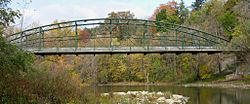Blackfriars Street Bridge facts for kids
Quick facts for kids Blackfriars Street Bridge |
|
|---|---|
 |
|
| Carries | 1 lane of roadway Pedestrians and bicycles |
| Crosses | Thames River |
| Locale | London, Ontario |
| Owner | City of London |
| Characteristics | |
| Design | Bowstring truss Pin connections and lattice girders |
| Material | Wrought iron, wood deck |
| Total length | 212ft, 64.6m (unsupported length) |
| History | |
| Constructed by | Isaac Crouse |
| Fabrication by | Wrought Iron Bridge Company |
| Opened | 1875 |
| Rebuilt | 2018 |
| Designated: | September 8, 2008 |
| Type: | Bridge |
| Designated: | April 21, 1992 |
The Blackfriars Bridge is a famous bridge in London, Ontario, Canada. It's a special type of bridge called a wrought iron bowstring arch truss bridge. It crosses the North Thames River.
This bridge was built way back in 1875. Today, it's used by cars (one lane at a time), bicycles, and people walking. It connects Blackfriars Street to Ridout Street North. At 216 feet (about 65.8 meters) long, it's the longest bridge of its kind still in use in North America!
Contents
What Makes the Bridge Special?
The Blackfriars Bridge is the oldest wrought iron bridge in North America that cars can still drive on. It's built with a unique "bowstring truss" design. Imagine a bow and arrow: the top part of the bridge is like the curved bow, and the bottom part is like the straight string.
The bridge's surface is made of wood planks. Underneath, there are strong iron beams that help support the weight of traffic. Even though it used to have two lanes, it's now a single lane because of how much traffic there is today.
The bridge is located near the North Thames River. There are nice paths for biking and walking along the river on both sides. Many trees surround the bridge, making it a beautiful spot.
A Look Back: Bridge History
The Blackfriars Bridge was made by a company called the Wrought Iron Bridge Company (WIBC) from Ohio, USA. A local builder named Isaac Crouse put it together in London, Ontario. Before this iron bridge, there were several wooden bridges here since 1831. But those bridges often got damaged by floods from the river.
This bridge is the oldest and most northern of eight bridges in the area. These bridges are important because they mark the historic center of London, Ontario.
Why is it so important?
The Blackfriars Bridge is special because of its age, the way it's built, the materials it uses, and how rare it is. Bridge experts say that "bowstring truss" bridges are very uncommon today. Most of them were built in the 1870s. It's amazing that this bridge has survived for so long!
These bridges are very detailed and beautiful. They have many parts that fit together like a puzzle. The curved top part gives them a simple and graceful look. The Blackfriars Bridge is considered one of the rarest and oldest iron bowstring truss bridges in Canada. Because of its importance, it has been named a historic structure.
Bridge Closures and Reopening
The bridge was closed to all traffic on May 13, 2013. This was so experts could check it out and plan for big repairs. The repairs were going to cost a lot of money, so the bridge stayed closed for a while. It reopened for people walking in December 2013.
After a big plan for rebuilding, the bridge was cut in half on November 27, 2017! It was then lifted onto the riverbanks and moved to another location for repairs. After a year of hard work, the Blackfriars Bridge was finally reopened to people, cars, and bikes on December 1, 2018.
Nature and Art Around the Bridge
Many people think the bridge looks like it's floating on the water. This is because of its curved shape and how lightly it rests on its stone supports. This design is quite rare compared to newer bridges.
The Blackfriars Bridge has even appeared in art, like a series of stained glass windows by an artist named Ted Goodden. Experts praise the City of London and the Province of Ontario for taking care of their old iron bridges. They say that the area around the Thames River still looks wild and natural, even in the middle of the city. This makes the bridge even more beautiful. You might even spot a Great blue heron (a large bird) near the river in winter!
Images for kids



